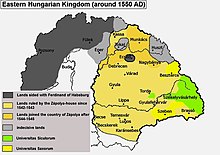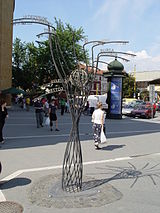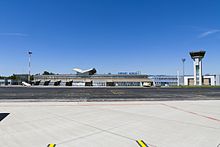Košice
There are heritage protected buildings in Gothic, Renaissance, Baroque, and Art Nouveau styles with Slovakia's largest church: the Cathedral of St. Elizabeth.The long main street, rimmed with aristocratic palaces, Catholic churches, and townsfolk's houses, is a thriving pedestrian zone with boutiques, cafés, and restaurants.[6][7] In Hungarian Koša → Kasa, Kassa with a vowel mutation typical for the borrowing of old Slavic names in the region (Vojkovce → Vajkócz, Sokoľ → Szakalya, Szakál, Hodkovce → Hatkóc, etc.).[11] Historically, the city has been known as Kaschau (in German), Kassa (in Hungarian), Kaşa (in Turkish), Cassovia (in Latin), Cassovie (in French), Cașovia (in Romanian), Кошице (in Russian, Ukrainian and Rusyn), Koszyce (in Polish) and קאשוי (Kashoy) (in Yiddish) (see here for more names).Below is a chronology of the various names:[12][13][14][15] Kingdom of Hungary 1000 – 1526 John Zápolya's Eastern Hungarian Kingdom 1526 – 1551 (Ottoman vassal) Hajduk rebels of István Bocskai 1604 – 1606 (Ottoman-backed) Principality of Transylvania (Ottoman vassal) 1619 – 1629, 1644 – 1648 Kuruc rebellion 1672 – 1682 (Ottoman-backed) Imre Thököly's Principality of Upper Hungary (Ottoman vassal) 1682 – 1686 Francis II Rákóczi's insurrection 1703 – 1711 Kingdom of Hungary (crownland of the Austrian Empire) 1804 – 1867 Austro-Hungarian Empire 1867 – 1918 Czechoslovakia 1918–1938 First Slovak Republic 1938 – 1945 Czechoslovakia 1945–1992 Slovakia 1993–present The first evidence of habitation can be traced back to the end of the Paleolithic era.The privileges given by the king were helpful in developing crafts, business, increasing importance (seat of the royal chamber[clarification needed] for Upper Hungary), and for building its strong fortifications.[17] As a Hungarian free royal town, Košice reinforced the king's troops at the crucial moment of the bloody Battle of Rozgony in 1312 against the strong aristocratic Palatine Amadé Aba (family).[21] The history of Košice was heavily influenced by the dynastic disputes over the Hungarian throne which, together with the decline of the continental trade, brought the city into stagnation.[15] On September 5, 1619, the prince of Transylvania, Gabriel Bethlen captured Košice with the assistance of the future George I Rákóczi in another anti-Habsburg insurrection.The 1664 Peace of Vasvár at the end of the Austro-Turkish War (1663-1664) awarded Szabolcs and Szatmár counties to the Habsburgs,[27] which put once more positioned Košice further inside the borders of Royal Hungary.Another rebel leader, Imre Thököly captured the city in 1682, making Kaşa once again a vassal territory of the Ottoman Empire under the Principality of Upper Hungary until 1686.[30] The city also became one of the centers of the Hungarian linguistic revival, including the publication of the first Hungarian-language periodical, called the Magyar Museum, in Hungary in 1788.The city's surroundings became a theater of war again during the Revolutions of 1848, when the Imperial cavalry general Franz Schlik defeated the Hungarian army on December 8, 1848, and January 4, 1849.[34] After World War I and during the gradual break-up of Austria-Hungary, the city at first became a part of the transient "Eastern Slovak Republic", declared on December 11, 1918, in Košice and earlier in Prešov under the protection of Hungary.Jews were allowed to enter the city during the town fair, but were forced to leave it by night, and lived mostly in nearby Rozunfaca.The town was bombarded on June 26, 1941, by a still unidentified aircraft,[36] in what became a pretext for the Hungarian government to declare war on the Soviet Union a day later.The German occupation of Hungary led to the deportation of Košice's entire Jewish population of 12,000 and an additional 2,000 from surrounding areas via cattle cars to the concentration camps.In 1946, after the war, Košice was the site of an orthodox festival, with a Mizrachi convention and a Bnei Akiva Yeshiva (school) for Jews, which, later that year, moved with its students to Israel.[38] The Soviet Union captured the town in January 1945, and for a short time, it became a temporary capital of the restored Czechoslovak Republic until the Red Army had reached Prague.[40][41] Košice lies at an altitude of 206 metres (676 ft) above sea level and covers an area of 242.77 square kilometres (93.7 sq mi).Košice has a humid continental climate (Köppen: Dfb, Trewartha Dcbo), as the city lies in the north temperate zone.Starting in 15 May 1944, during the German occupation of Hungary towards the end of World War II, approximately 10,000 Jews were deported by the Nazis, with the enthusiastic assistance of the Hungarian Interior Ministry and its gendarmerie (the csendőrség).[58] The last transport to Auschwitz left the city in 2 June, three months before the Arrow Cross Party gained control over Hungary.The ethnic makeup of the town was dramatically changed by the persecution of the town's large Hungarian majority, population exchanges between Hungary and Slovakia and Slovakization and by mass migration of Slovaks into newly built communist-block-microdistricts, which increased the population of Košice four times by 1989 and made it the fastest growing city in Czechoslovakia.Project Interface aims at the transformation of Košice from a centre of heavy industry to a postindustrial city with creative potential and new cultural infrastructure.The main project venues are: The first and the oldest international festival of local TV broadcasters (founded in 1995) – The Golden Beggar, takes place every year in June in Košice.As part of the growing ICT field, Košice IT Valley association was established in 2007 as a joint initiative of educational institutions, government and leading IT companies.In addition to St. Elizabeth, there is the 14th century St. Michael Chapel, the St. Urban Tower, and the Neo-baroque State Theater in the center of town.The city hosts a regional branch of the National Bank of Slovakia (Národná banka Slovenska) and consulates of Belgium, Greece, Hungary, Russia, Spain and Turkey.The city is connected by rail to Prague, Bratislava, Prešov, Čierna nad Tisou, Humenné, Miskolc (Hungary), and Zvolen.












Kosice (disambiguation)Cathedral of St. ElizabethSt Michael ChapelState TheaterCoat of armsSlovakiaKošice Self-governing RegionKošice IKošice IIKošice IIIKošice IVDemonym(s)Time zoneArea codeNominalHornádSlovak Ore MountainsBratislavaKošice RegionSlovak Constitutional CourtEuropean Capital of CultureMarseilleU.S. Steel Košicesteel millinternational airportheritageGothicRenaissanceBaroqueArt Nouveaupedestrian zoneits own coat-of-armspersonal nameSlavicVojkovceSokoľHodkovceGermanHungarianTurkishFrenchRomanianRussianUkrainianPolishYiddishKingdom of HungaryJohn ZápolyaEastern Hungarian KingdomOttomanHajdukIstván BocskaiPrincipality of TransylvaniaImre ThökölyPrincipality of Upper HungaryFrancis II RákócziAustrian EmpireAustro-Hungarian EmpireCzechoslovakiaFirst Slovak RepublicPaleolithicMongol invasionBéla IV of HungaryZipser GermansGermans of HungaryAbauj Countytown privilegesinternational tradeAdriaticAegeanBaltic SeaUpper Hungaryfree royal townBattle of RozgonyAba (family)own coat of armsLouis I of HungaryCivitates orbis terrarumSt. Elisabeth CathedralSigismundapostolic seePentapolitanaleagueBardejovLevočaPrešovSabinovMatthias CorvinusVladislaus III of VarnaJohn JiskraBohemiaJohn I Albertthe Holy Roman Emperor Ferdinand IStephen BocskayHabsburg dynastyGeorge I RákócziGiorgio BastaTreaty of Vienna (1606)Ottoman EmpireGabriel BethlenPeace of NikolsburgPartiumUgocsa CountyBereg CountyZemplén CountyBorsod CountySzabolcs CountySzatmár CountyAbaúj CountyCatherine von HohenzollernJohann Sigismund Kurfürst von BrandenburgViennaCounter-ReformationJesuitsEmperor Leopold IPeace of VasvárAustro-Turkish War (1663-1664)Royal HungarycitadelAustrianAeneas de Capraratook Košice backOttomansPrince of TransylvaniaWar for IndependenceSzepes County

